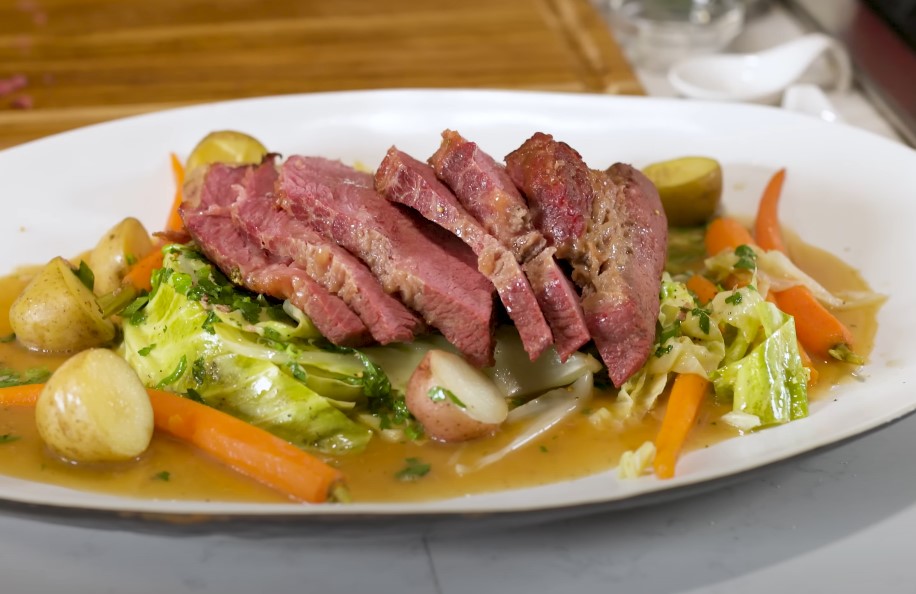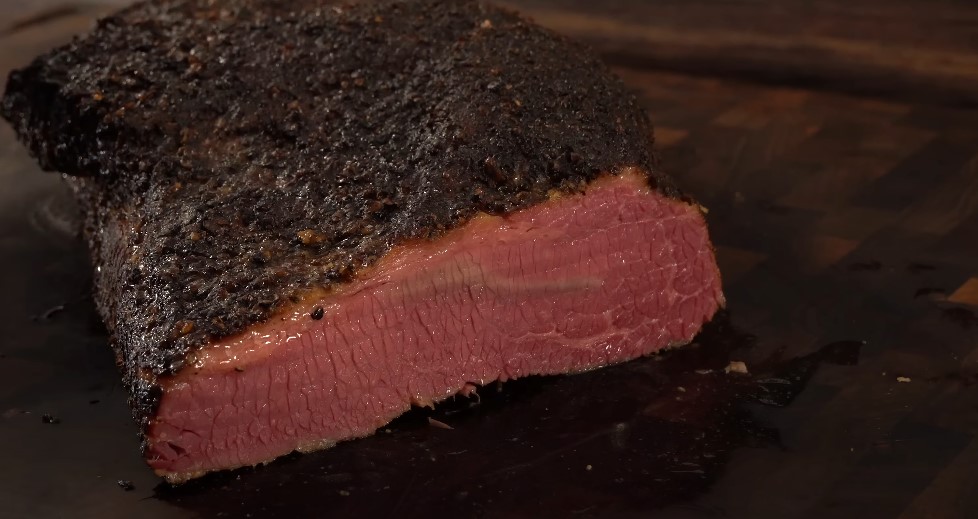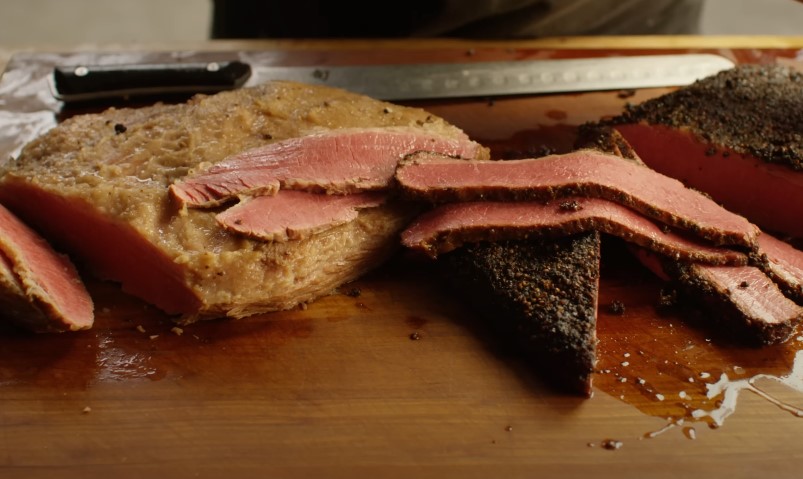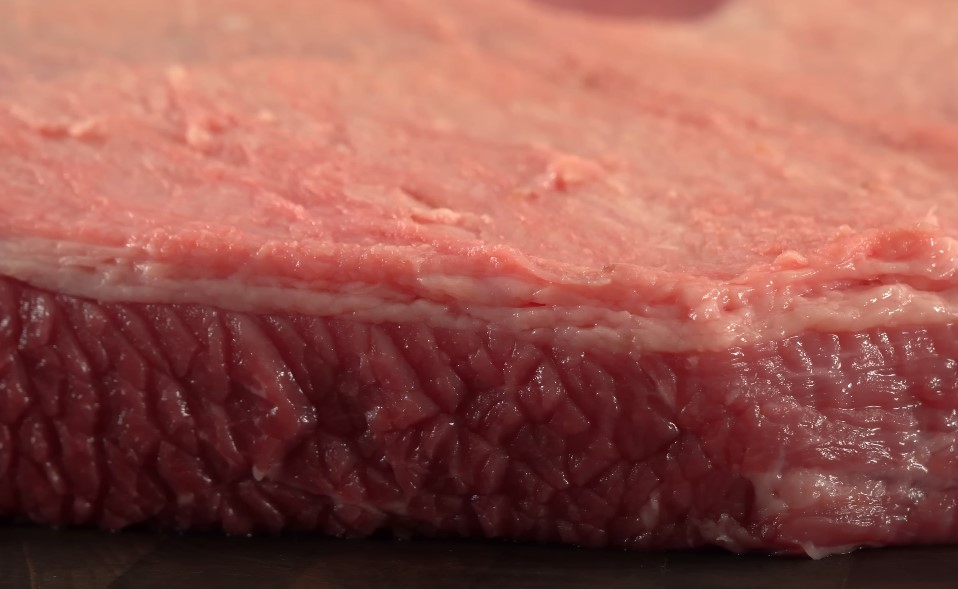Have you ever found yourself standing in front of a deli counter, torn between ordering pastrami or corned beef?
You’re not alone!
Let’s take a look into the delicious world of these two classic meats so you can make an informed—and tasty—decision next time.
The Cuts of Meat
- Corned Beef: Typically made from the brisket, which comes from the lower chest of the cow. This cut is relatively lean but can be tough if not cooked properly.
- Pastrami: Traditionally made from the navel end of the brisket, which is fatty and flavorful. Sometimes, pastrami is also made from beef round or even turkey for a leaner option.
So when you’re biting into corned beef, you’re tasting brisket, while pastrami often offers a richer, fattier experience.
The Curing Process
Both meats undergo a curing process, but the ingredients and techniques vary.
Corned Beef Curing
- Brining: Corned beef is soaked in a brine solution made of water, large grains of rock salt (that’s where the “corned” comes from), sugar, and spices like juniper berries, mustard seeds, and bay leaves.
- Duration: The meat cures for several days to a week, allowing the flavors to penetrate deeply.
Pastrami Curing
- Dry Rub: Pastrami is coated with a mixture of spices including coriander, black pepper, paprika, garlic, and sometimes a touch of sugar.
- Smoking: After curing, pastrami is smoked, which adds that distinctive smoky flavor you might love.
Cooking Methods

The way these meats are cooked contributes significantly to their taste and texture.
Corned Beef Cooking
- Boiling or Steaming: Corned beef is usually simmered for several hours until it’s tender. This moist cooking method helps break down the tough fibers in the brisket.
- Texture: The result is meat that’s tender yet firm, easy to slice, and perfect for sandwiches or traditional meals.
Pastrami Cooking
- Smoking: After curing, pastrami is smoked at low temperatures. This can take up to several hours.
- Steaming: Before serving, pastrami is often steamed to reheat and add moisture.
- Texture: This process yields tender, juicy meat with a smoky, spicy crust.
Flavor Profiles

- Corned Beef: Salty and mildly spiced, with a cured meat flavor. The brine gives it a distinctive taste that’s both savory and slightly tangy.
- Pastrami: Richer in flavor due to the spice rub and smoking process. You’ll notice smoky notes combined with peppery and garlicky spices.
If you prefer straightforward, salty meat, corned beef is your go-to. If you’re in the mood for something with a complex, smoky, and spicy flavor, pastrami is the way to go.
Traditional Uses
Corned beef is most famously associated with the classic corned beef on rye, served simply with a smear of mustard. This sandwich highlights the meat’s salty, savory taste, making it a favorite in delis across the country.
Beyond sandwiches, corned beef is also a key component of meals like corned beef and cabbage, often served alongside potatoes, especially during St. Patrick’s Day celebrations. This hearty dish brings out the meat’s tenderness and its slightly tangy brined flavor.
For breakfast lovers, corned beef hash is another popular option, where diced corned beef is fried up with potatoes and onions, making for a savory, filling meal that pairs well with eggs.
On the other hand, pastrami’s most iconic use is in the beloved pastrami on rye, typically piled high with mustard and pickles. This sandwich, with its rich smoky flavor, is a star at Jewish delis, especially in New York City, where pastrami has become a cultural staple.
Pastrami can also be combined with corned beef in what is sometimes called a “combo” sandwich, creating a deliciously meaty experience for those who want the best of both worlds.
For fans of the Reuben sandwich, which is traditionally made with corned beef, pastrami can be a flavorful substitute, adding a spicier, smokier dimension to the sandwich when paired with sauerkraut, Swiss cheese, and Russian dressing on rye bread. Also, don’t forget the lettuce!
Here’s a quick comparison of how these meats are traditionally used:
| Corned Beef | Pastrami |
|---|---|
| Classic corned beef on rye with mustard | Pastrami on rye with mustard and pickles |
| Served with cabbage and potatoes (St. Patrick’s Day) | Combo sandwiches with corned beef and pastrami |
| Corned beef hash with potatoes and onions | Substitute for corned beef in Reuben sandwiches |
Cultural Origins

- Corned Beef: Has roots in Irish cuisine, but interestingly, it’s more popular in America than in Ireland. Irish immigrants in the U.S. adapted their traditional recipes using beef brisket instead of pork.
- Pastrami: Originated from Romanian Jews who brought the recipe to the U.S. It’s a staple in Jewish delicatessens, especially in New York City.
So when you’re enjoying corned beef or pastrami, you’re also partaking in a rich cultural history.
Nutritional Differences
- Calories: Pastrami is generally slightly higher in calories due to the fat content from the navel cut and the smoking process.
- Fat Content: Pastrami tends to be fattier, which contributes to its juiciness and flavor.
- Sodium: Both meats are high in sodium because of the curing process. Corned beef might have a bit more due to the brining.
Always consider portion sizes and perhaps balance your meal with lighter sides like salads or steamed vegetables.
Making the Choice

- Flavor Preference: Do you like smoky and spicy? Go for pastrami. Prefer salty and tangy? Corned beef is your pick.
- Texture Desire: Pastrami offers a fattier, more tender bite. Corned beef is firm yet tender.
- Meal Context: For a classic Reuben sandwich, you might choose corned beef. If you’re at a Jewish deli craving an authentic experience, pastrami is the star.
Fun Facts to Impress Your Friends
- “Corned” Beef: The term “corned” comes from the large grains of salt, called “corn” of salt, used in the curing process.
- Pastrami Popularity: Pastrami became popular in the U.S. in the late 19th century and was a way to preserve meat before refrigeration.
- Culinary Fusion: Some chefs now experiment with pastrami made from turkey or even salmon, offering a twist on the classic.
Conclusion
Now that you’ve explored the main differences between pastrami and corned beef, you can confidently make your choice the next time you’re at the deli. Whether you opt for the smoky, spicy goodness of pastrami or the salty, savory flavor of corned beef, you’re in for a delicious treat.
So go ahead—indulge in that towering sandwich and savor every bite, knowing exactly what makes your meat of choice special.
Enjoy your meal!

